
Mamukala Billabong, Kakadu NP, Australia
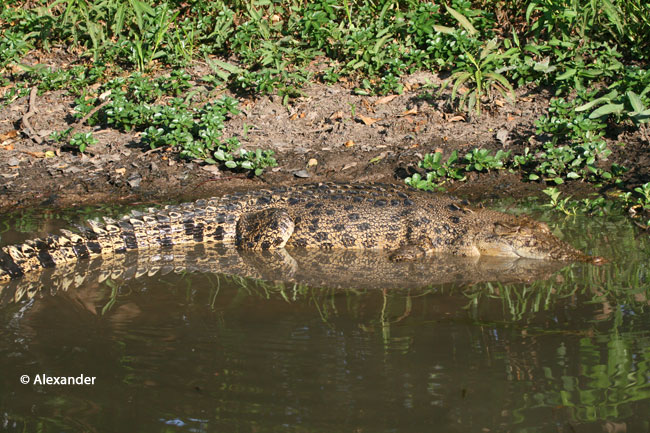
Saltwater Crocodile, Kakadu NP, Australia

Agile Wallaby, Kakadu NP, Australia
Here’s a park so big that it has four river systems. It is loaded with wildlife, some that eat humans. It dates back tens of thousands of years; and although it’s accessible, most people will never get here.
Kakadu National Park is a vast expanse in the northern tip of the Northern Territory of Australia. It covers 7,646 square miles (19,804 sq. km) and holds the double distinctions of being a UNESCO World Heritage Site as well as a Ramsar Wetland.
There are two basic seasons in Kakadu: dry and wet. Like many wilderness areas in the world, the dry season in Kakadu means the water sources have shrunken, which brings the wildlife closer to the water and more available for observing. The wet season brings monsoons and flooding.
More info about Kakadu: Wikipedia and Parks Australia
We were there in the dry season, in September of 2010. As birders we stayed focused on the wetlands, foregoing the waterfalls and other land features spanning this enormous park.
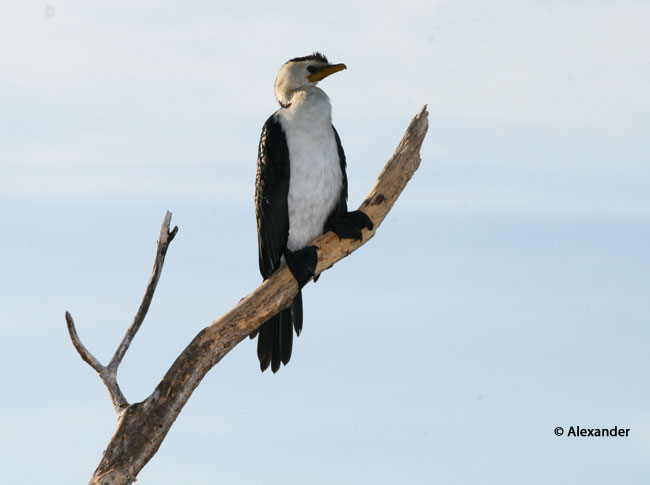
Pied Cormorant, Kakadu NP, Australia
Due to the extremes in temperatures and conditions, accommodations and human establishments were few. We stayed at the only lodge in the park to be closer to the wildlife.
Every day by noon the thermometer hovered around 110 degrees Fahrenheit (43 C.), so we did most of our exploring in the very early morning and late in the day.

Forest Kingfisher, Kakadu NP, Australia
Probably our favorite activity was the Yellow Water Boat cruises, cruising in a pontoon boat through the wetlands. We had safe and close-up views of saltwater crocodiles and wetland birds.
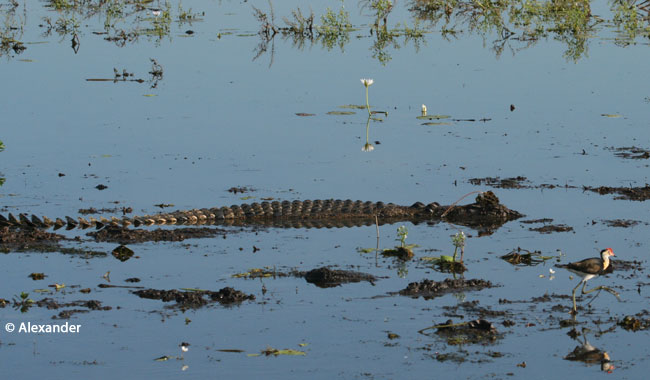
Crocodile and Comb-crested Jacana, Kakadu NP, Australia
The largest living reptile on earth, saltwater crocodiles (Crocodylus porosus) also have the greatest bite pressure measured in any living animal. Salties, as the Australians call them, can stay hidden underwater for an hour, eventually lunging up to grab their prey and devour it. They look deceptively docile.

Saltwater Crocodile, Kakadu NP, Australia

Comb-crested Jacana, Kakadu NP, Australia
Predators abound in this harsh wilderness. We watched in awe as this female Australian Darter wrestled with a large fish…and stayed until the fish’s tail went sliding down her throat.

Australian Darter, female, Kakadu NP, Australia
This four-foot stork (50 inches tall or 127 cm) foraged in the lily flowers.
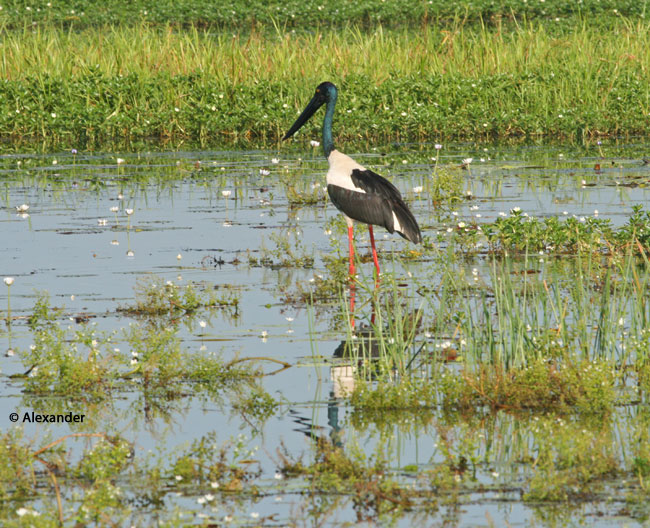
Black-necked Stork, aka Jabiru, Kakadu NP, Australia
Equally as enticing were some enormous escarpments: steep, rocky plateaus jutting out of the floodplains. We visited two of the more well-known rock formations that were highlighted with Aboriginal rock art, Ubirr and Nourlangie Rock.

Escarpment and Termite Mound, Kakadu NP, Australia
The rock art dates back about 20,000 years. Sources vary as to the exact age of the drawings, but the origin of the artists is undeniably Aboriginal.
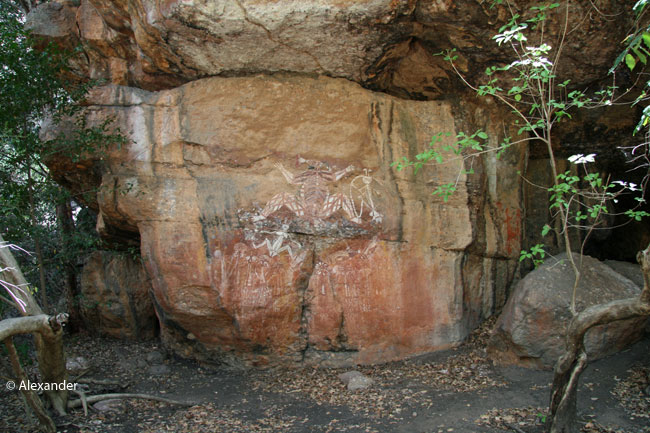
Aboriginal Rock Art, Ubirr, Kakadu NP, Australia

Aboriginal Rock Art, Long-necked Turtle, Kakadu NP, Australia

Aboriginal Rock Art, Kangaroo, Kakadu NP, Australia
The Aboriginals drew pictures not only as expression, but as part of their dream culture, striving to encourage the spiritual world to bestow an abundance of wildlife for hunting, healthy offspring, and other human riches.
By visiting these rock art sites and learning about the original people, a curious thing happened. The past fused with the present, and all of humanity came alive.
It heightened the sacredness of this place.
Link to Rock Art at Kakadu National Park.
Most nights after the heat had diminished by about 20 degrees, a simple walk through the adjacent campground became a fun activity. Due to crocodiles, walking around the wild and watery places was not safe.
So we looked for birds in the campground, where vacationing Australians in their “caravans” (van-size campers) were cooking their dinners and socializing. It was a raucous scene most nights, and endlessly interesting. Up above us in the surrounding trees were unique birds.

Rainbow Bee-eater, Kakadu NP, Australia
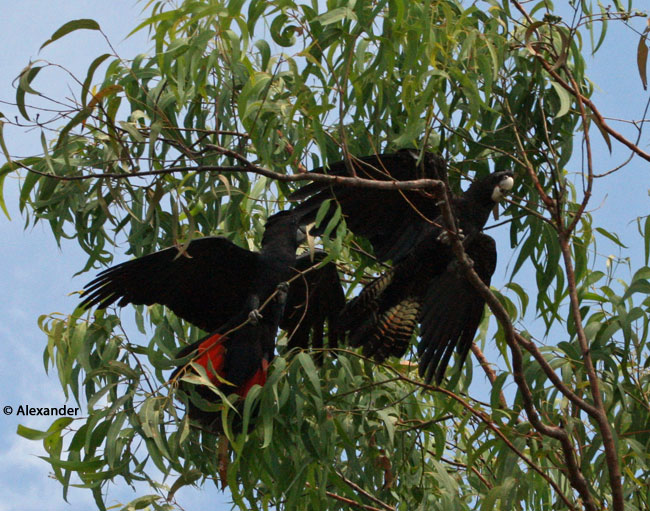
Red-tailed Black Cockatoo pair in Gum Tree (male on L, female on R), Kakadu NP
In the campground we stood out as birders in our geeky clothes and equipment; and two college students befriended us. They called us “twitchers” (birders) and took us to see owls and stone-curlews, and listen to unusual frogs.
The mornings were filled with sightings of birds and crocodiles and beautiful wetland scenes, until it got too hot.

Australian Darter, male, Kakadu NP, Australia

Nankeen Night Heron, Kakadu NP, Australia

White-bellied Sea Eagle, Kakadu NP, Australia
We spent the afternoons submerged in the lodge swimming pool or reviewing our bird studies. At night the geckos in the room got loud, and we ventured out to the campground.
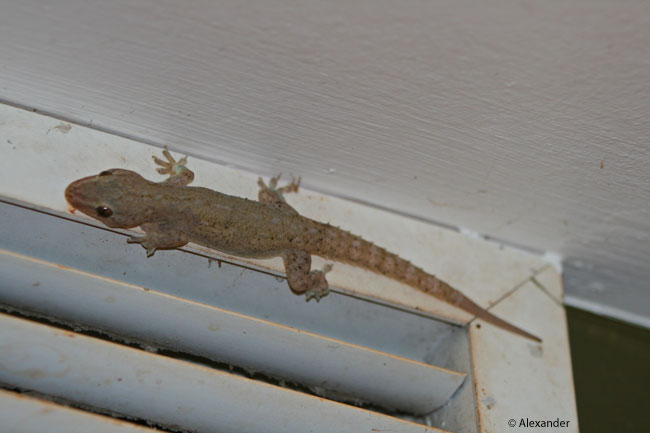
Asian House Gecko, Kakadu NP, Australia
When our week in Kakadu came to a close, we returned to the Northern Territory’s biggest city (Darwin) about a four-hour drive away. In the pre-dawn morning we boarded a flight for the next leg of our journey on the Great Barrier Reef.
As we continued our Australian adventures, the sacredness, beauty, raw wildness, and danger of Kakadu blissfully remained with us. Thanks for sharing this adventure.
Written by Jet Eliot.
Photos by Athena Alexander.

Wetland at Sunset, Kakadu NP, Australia

A stunning post on a literally magical place. Thanks, Jet.
Yes, it is a magical place, and how wonderful to be able to share it. Thank you for your visit and lovely words, Michael.
What a beautiful place, wow! I would love to visit Australia, a magical place. Athena always does a wonderful job capturing photos. Thanks, Jet! ☺️
I am delighted to share the beauty and magic of Kakadu with you, John, and am glad you enjoyed it. Always pleasant to “see” you, thanks for stopping by.
Your welcome, nice to “see” you guys again! 😂😎
Great adventure with wonderful photos.
Fun to share this adventure with you, Timothy. Thanks for your visit today.
You and Athena have sure seen some amazing sights. Wonderful pictures and write-up.
Yes, we are fortunate to have seen many amazing sights and creatures. Thank you, Anneli. Always a pleasure to have you stop by.
Dear Jet…now that really is a special place…and how wonderful that you were able to be there to have your senses drenched in it all.
The rock art is beyond amazing…simply stunning. The wildlife extraordinary and those crocs truly awesome.
Thank you so much for sharing this with us. Janet :)X
I sure enjoyed composing this post, Janet, and am really glad you found it fun. Yes, the rock art is truly stunning. I know you would like it. The paint colors are made from different minerals and the web link gives details of exactly what the minerals were. Thanks so very much for your visit and comment. It was a delight to touch base with you.
Always good to touch base with you. I hope the fires have not been too close! I am thinking about you a lot. x
Thanks for your warm thoughts and concerns, Janet. So far so good. The fires are not close and our air is still breathable. Sending smiles your way….
I had never heard of Kakadu, Jet, and was entranced by the photos and accompanying text. I doubt I will ever have an opportunity to experience it first-hand, so this was a lovely “arm-chair” visit (cooler, too). Thanks!
I had never heard of Kakadu either, Donna. We were convinced to set aside the time to visit there by a guide who absolutely loved Kakadu. I’m glad we took his advice. I appreciated your comment and am glad I could give you a vicarious and cool visit to Kakadu. Thank you.
It sounds like you had an amazing trip! I’ve only managed a trip to Melbourne, but recall the very distinctive sound of a bird in the zoo, which the ranger told me was a Bell bird (or something like that). It certainly had a distinctive ‘dong’!
Gosh, Mike, you wouldn’t believe how strange and exotic the rainforests and trees sound in parts of Australia, with all their unusual birds. Thanks so very much for your visit and comment.
Thought I had seen all the Kingfishers, but the Forest is a new one for me – thanks for the introduction
I am happy I could introduce you to a new kingfisher, Brian. That forest kingfisher was a lifer, and what a beautiful bird. Thanks for your visit today.
Look at those photographs. What a fabulous post with so many great photos!
Always wanted to travel Australia. Thought of the many places you presented that
did indeed beg for travel. Look what you have done! Now there is fresh curiosity!
Keep it going Jet!
I’m smiling, dear Eddie, at your wonderful comment. So glad I brought you fresh curiosity, and that you enjoyed the photos and post of Kakadu today. Always a great pleasure, my friend.
Another wonderful trip. My wife and I would love something like that. I finally made it to the zoo after a year to see the new Stellar’s Sea Eagles. They were every bit as incredible as I imagined them.
Yes, the sea eagles are really impressive birds, Craig, including our Bald Eagle. I just popped into Wikipedia to check on the Steller’s Sea Eagles and see that they are the biggest weighing up to 20 pounds. I bet they WERE incredible! Thank you, Craig, always a joy.
Photo on my blog, but it’s from a zoo.
What a massive bird! That bill looks like something a toucan would wear. Thanks so much, Craig, I enjoyed the photo VERY much. How fortunate that you got to see them in spite of the Covid delay. Very cool.
I spent a long time with them. I was just so impressed.
What a place to visit, so full of life, in and around the water! Predators of all shapes and sizes to keep you on your toes, and so much to take in. Loved the rock art, absolutely beautiful.
Thanks to you both for this thrilling post, and it is a reminder that we will get ourselves to Australia at some point!
Yes, you’re right, pc, the predators of Australia did keep us on our toes. I’m glad you enjoyed the rock art, too. It was beautiful and humbling. I really appreciate your visit and words today, pc, as I do every week. I hope you and Mrs. pc have a rockin’ weekend.
Oh, what a wonderful trip this must have been! The birds and crocs are amazing! I think my favorites in this post are the Rainbow Bee-eater, and the Sea Eagle.
This was a wonderful arm-chair tour!! Thank you, Jet, and Athena!
I am happy I could bring you along to Kakadu with us today, Deborah, and so very glad you enjoyed the birds and crocs. We were lucky to see many sea eagles there, and the rainbow bee-eaters are pure delight. Many thanks.
An area i knew nothing about Jet. I like the idea of being on the pontoon boat, A safe location way from the human eaters. Gulp. It looks like bird watching paradise.
As to the art dating back 20,000 years ago, I am amazed how well preserved it is. I saw another post on Australian ancient art and made the same comment. such drawings here in Canada fade more easily. I’m guessing the winter weather and thaw melt cycle make the difference. What do you think?
Hi Sue, a joy to see you here today. I was just reading on the Kakadu website that the officials there are now trying new methods to help preserve the rock art like providing boardwalks and handrails to prevent people from touching it. They also put silicon drip lines around the paintings to redirect water flow. I can’t imagine how they get through monsoon season every year, but I feel lucky I was able to see these sacred paintings. My warm thanks for your visit today, and best wishes to you and Dave.
I love that cave art … so beautiful. That shot of the Nankeen Night Heron would make an great painting.
I’m really glad you liked the rock art, Jan, it’s pretty special. And although I never thought about it, I agree with you on the Nankeen Night Heron photo, it would make a great painting. That heron posed like that for many minutes, it was very intent on its prey. Many thanks and cheers to you, Jan.
Wow, what a *fabulous* adventure. And Athena produced some of the best photos I’ve seen out of her camera. 🙂
Athena was very busy with her camera that week in Kakadu, so I’m really glad you enjoyed her photo work. It was so hot, too. My warmest thanks for your kind words, Frank. Your prairie photo this morning was also a great joy.
Thanks for this post of an intriguing place I’ll probably never get to in person. Not complaining, just stating a fact. The photos are wonderful, especially the darter with that enormous fish. I’m sure the boat trip was wonderful and such a great way to be able to see things…when you don’t have to drive. 🙂 You’ve really been all over the world. What a blessing that is and I enjoy sharing a little part of that blessing.
Watching that darter eat that fish was awesome, Janet. It was a wiggly fish who put up a good fight, and it had a very sharp, pointy snout that makes me wonder how it must’ve felt to the bird to have it going head-first into her throat. Yes, it’s been a blessing to have travelled to many parts of the world, and I am truly delighted to be able to share some of it with you, Janet. Thank you.
The world is getting too small for you, my friend. I always think, “I wonder where my friend Jet is? Kakadu NP, Australia?…Oh,there! I have a great idea, why don’t you adopt me? 🙂
Your post has a tremendous amount of excitement and super interesting animals. You never let me down! Thank you for the tour. 🙂
Big smile on my face, H.J., after reading your comment. I am thrilled I could share beautiful Kakadu with you today. It was a place that I had never heard of, that a guide who loved it urged us to go to. I am happy I could take you on the tour today, and grateful for your warm and friendly words. Thanks so much, my friend.
You two have the best adventures! What a wild and beautiful place, so filled with life, but boy, I bet it was scorching!
Our Australia adventure was magnificent. We had several major areas that we covered so the timing with the weather and guides, the planning, the orchestration was quite a feat. It was scorching in the North, but we had to time it before the monsoons hit and when the weather in the south was decent too. I am really glad I could share it with you today, Eliza, thanks very much for your interest.
What a wonderful Park — you guys are well traveled. Had to be a little scary with the saltwater crocodiles hiding in the bushes
Yes, those saltwater crocodiles were quite menacing, but we learned FAST how to behave. Thank you so much for your visits every single week, Bill, it is much appreciated.
Wonderful photos and information thank you. I particularly enjoyed the aboriginal rock art photos. Looks like quite the adventure. Neither of us have been to Australia – maybe one day!
Peta
Hi Peta, wonderful to “see” you today, and I’m happy I could share the magic of Kakadu with you. Knowing how well traveled you and Ben are, I am certain you will visit Australia if you so desire. I recommend a first visit to the continent in the states of New South Wales and Queensland, vast country with some parts in rainforest, and all bordering on the Great Barrier Reef including islands off the coast. Cheers to you, and many thanks.
What a beautiful, and unique environment. Your words and Athena’s photos make your trip come alive for me. thanks Jet.
Thanks very much, Brad, for your kind words and visit. That the Kakadu post came alive for you was a gift to hear. Sending smiles your way.
Thanks for the smiles Jet. 😀
How utterly exotic. I love that you had yourself some locals to help out with your ‘twitching’… 😉
What a treat to go on these adventures with you and Athena yet still enjoy all the convenience of home… 😏 without the crocodiles! I believe you two are, hands down, the most intrepid folks I ‘know’!
We had great fun on that adventure largely due to the locals. Many of the Australians we came upon were friendly and free with their words, leading us to spots we never would’ve found. An old woman in a post office where we were buying post card stamps told us where we could find a rare pair of cockatoos (we did); another pair told us about a parking lot near a gravel pit where we might find Gouldian Finches (we didn’t), and on and on it went. Really fun. I am smiling ear-to-ear at your delightful words here, Gunta. Thank you, as always, for your colorful visit — always a joy.
Those crocodiles are impressive. The photo of the one with the opened mouth looks as though it’s bitten off a chunk of sunshine and swallowed it — and it just might be able to pull that off. I enjoyed seeing the Nankeen night heron, too: so much like our night herons. But I’ll confess the gecko at the end tickled me most, perhaps because it’s the most familiar. The markings seem slightly different from those that roamed my house in Liberia, but no matter; I’m sure the ones you found there are equally adept at catching mosquitoes and other prey!
Your adventures with traveling and living in exotic places, Linda, has no doubt widened your experiences in life, and so you know the story with geckos who live in the rooms and never leave. We just get used to it. And the crocodiles were so very huge, definitely the biggest reptiles, and most foreboding, that I have ever seen. Great fun to share this adventure with you, thank you for coming along.
What beautiful birds and wonderful shots, thank you for sharing this park, it is amazing with its diversity!
Thank you, Donna, it was a privilege to share the many delightful creatures of Kakadu with you.
Dear Jet,
what a great place for wildlife. Thanks for taking us there and sharing your experience what we thoroughly enjoyed.
Great pictures and text 👍 Thanks for all the info.
Keep well
The Fab Four of Cley
🙂 🙂 🙂 🙂
Hiya Fab Four. Thanks for your kind words and visit, I am happy you enjoyed the Kakadu adventure, it is great to share it with you.
I miss AU. Love to see more wildlife there someday. 🙂
The wildlife in AU is so very different. I’m glad you have had the chance to see it, Sherry. Thanks so much for your visit, always great to see you.
Wow. Just wow. I actually began to sweat, entering this magical (hot) place with you both thanks to Athena’s photos and your text. To see wild beauty like this, you have to endure the heat, “raucous” nights, gecko calls, and crocodile threats. I felt like I was reading an adventure book! Well done, as always.
Thanks so much, Pam, for your descriptive words and sentiments. I’m thrilled that I was able to bring this Australian Kakadu adventure so vividly to you. Really appreciated your visit and comment.
Amazing postcards, Jet. Especially love the birds. 😊❤️
Great that you enjoyed the postcards, Irene. The birds in Australia are extraordinary, that’s why we went there, so I’m really glad that you had fun looking at them. Thank you.
Great travelogue, Jet. And a lot of wonderful pictures of your experiences there. The whole world is getting hotter and I believe Australia was already one of the hotter spots on Earth. Love the glow from within the crocodile. 🙂
Hi Steve. I like the glow inside that crocodile’s mouth too. There are a few subtle differences between fresh water and salt water crocs, and one of them is their teeth. The salt water’s are all different sizes. So that photo was a good demonstration of the teeth as well. Always a pleasure to have you stop by, thank you.
What an amazing national park! I was struck with the similarities and differences in the appearance of the pied cormorant and our local double-crested cormorants. The blues of the forest kingfisher’s feathers were so beautiful. I also appreciated your moments of transcendence at the Aboriginal rock art sites. Thanks for sharing this wonderful experience!
I so enjoyed reading your comment and hearing your observations and warm words, Barbara. Visiting foreign countries and absorbing the similarities and difference in the bird species is one of the thrills of my life, and I’m happy I could share them with you. Thanks for being so receptive and astute. I hope your day is filled with sweet images.
What a magnificent place to visit!… although I’m glad to visit it through your postcards rather than in person! Such an interesting variety of creatures, stories, experiences! Thanks for sharing.
Oh yes, Kakadu was lively with all kinds of adventures. I am so very glad I could share it with you, Nan, thank so much for stopping by.
How wonderful that must have been for you! New creatures to see everywhere you look. About those crocodiles, though….. Scary!! And do the geckos ever stop making noise?
Cheers,
Julie
It was great fun sharing the Kakadu adventures, Julie, and I’m really glad you enjoyed them. Those geckos squeak and chatter so much, funny little guys. Thanks very much for dropping by.
No, thank you for sharing this adventure!
The birds are stunning! The Rock Art really got me. It’s an early form of street art….. in a way!
Thank you both of you!!!
Be well!
That’s right, the rock art was an early form of street art. I’m really glad you stopped by so you could see it, Resa, as you are the wall art guru. Thanks so much for stopping by.
Wonderful nature photos by Athena and narrative by you, Jet. The kingfisher and bee eater are gorgeous and the crocs are amazing. The rock drawings are fascinating and beautiful- we saw some at Uluru. Very cool that you got to this seemingly very remote part of the country.
There aren’t too many tourists who go to the Northern Territory or Kakadu, and if we hadn’t had a guide years earlier who loved Kakadu so much and highly recommended it, I doubt we would’ve gone to the trouble of going all the way up there. But it was one of the most curious places I’ve ever been. And I’m glad I could share some of its wonder with you here. Thanks so much, Jane.